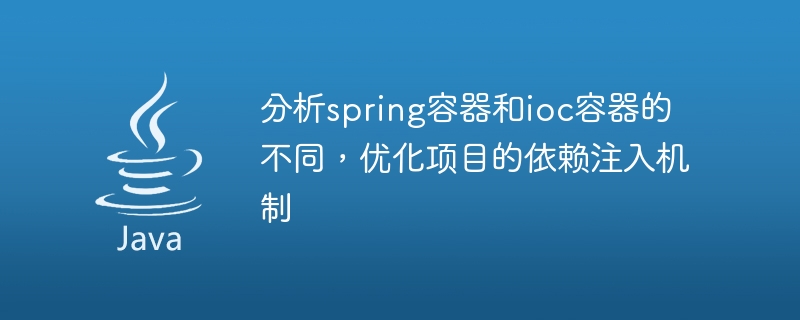

Title: The difference between Spring container and IOC container and the optimization of project dependency injection mechanism
Step 1: Introduce Spring dependencies
Introduce the relevant dependencies of the Spring framework in the project's pom.xml file. For example:
<dependency>
<groupId>org.springframework</groupId>
<artifactId>spring-context</artifactId>
<version>5.0.8.RELEASE</version>
</dependency>Step 2: Define dependency injection objects
In the project, define the objects that need to be injected and their dependencies. For example, define a UserService interface and its implementation class UserServiceImpl:
public interface UserService {
void addUser(String username, String password);
}
public class UserServiceImpl implements UserService {
private UserRepository userRepository;
// 构造器注入
public UserServiceImpl(UserRepository userRepository) {
this.userRepository = userRepository;
}
public void addUser(String username, String password) {
// 调用userRepository中的方法,完成用户添加的逻辑
}
}Step 3: Configure the Spring container
Create a Spring configuration file to configure the objects that need to be injected and their dependencies. For example, create a Spring configuration file named applicationContext.xml:
<beans xmlns="http://www.springframework.org/schema/beans"
xmlns:xsi="http://www.w3.org/2001/XMLSchema-instance"
xsi:schemaLocation="http://www.springframework.org/schema/beans http://www.springframework.org/schema/beans/spring-beans.xsd">
<bean id="userRepository" class="com.example.UserRepositoryImpl" />
<bean id="userService" class="com.example.UserServiceImpl">
<constructor-arg ref="userRepository" />
</bean>
</beans>Step 4: Obtain the injected object
Where the injected object needs to be used, obtain the object through the Spring container. For example, create a Java class named Main:
public class Main {
public static void main(String[] args) {
ApplicationContext context = new ClassPathXmlApplicationContext("applicationContext.xml");
UserService userService = context.getBean("userService", UserService.class);
// 调用userService中的方法
userService.addUser("Tom", "123456");
}
}Through the above steps, we successfully optimized the dependency injection mechanism of the project. Using the Spring container, we no longer need to manually create dependent objects, but manage and organize them through configuration files.
The above is the detailed content of Compare the differences between spring containers and ioc containers, and improve the project's dependency injection mechanism. For more information, please follow other related articles on the PHP Chinese website!




